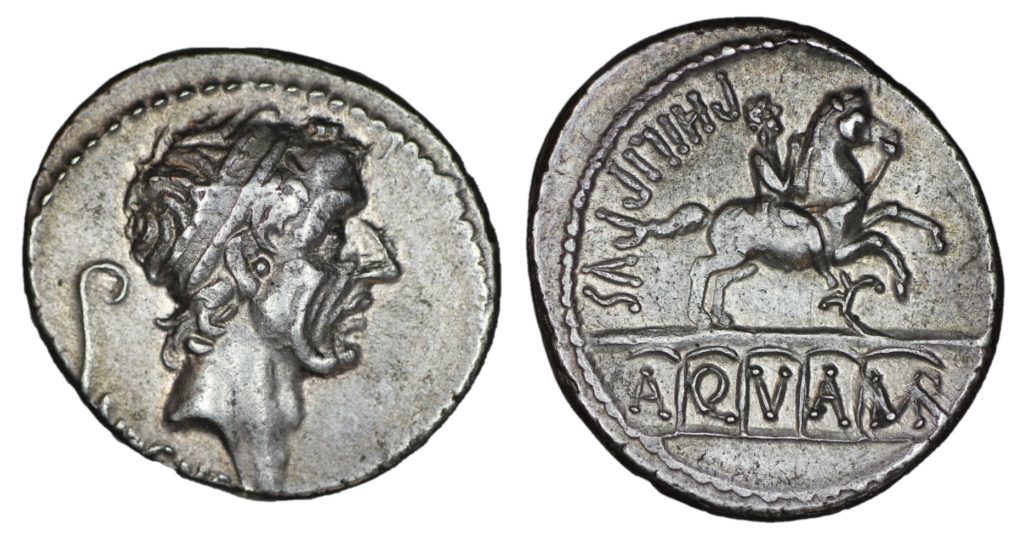
In a previous post (here) I talked about a coin which showed a racing horse, slender and lean, and a venerable depiction of Apollo. On this coin we see a horse with entirely different conformation, and a very different portrait. To start with the image on the obverse. The portrait looks individualised, like it was based on a real person. However, the subject of the image is Ancus Marcius, the fourth king of Rome, from whom the family claimed descent (and proved their antiquity, importance, and so on). While Roman families of note kept busts of their ancestors modelled from death-masks, which would make appearances in their grand funerals, whenever a scion of the family died and joined the ranks of the ancestors rather than the living, this portrait cannot be based on one of those. Ancus Marcius lived about six centuries prior to this coin.
The image is therefore a fantasy, perhaps based on familial characteristics, but largely constructed to communicate a message rather than a likeness. What then is this message?
Republican portraiture could utilise different idioms, different “styles” according to the message they wanted to convey. At the time of this coin, one of the popular idioms was so-called verism.
The term is etymologically slightly misleading, as it seems to imply “life-like” or, worse, “realistic”. (How can a depiction be realistic when it is on a fifteen millimetre high, all but flat silver disc? How even can a photograph be realistic? No one is two dimensional and made of coloured inks). Instead, verism, and veristic portraiture is characterised by a desire to exaggerate and emphasise indications of age, favouring wrinkes, creases, and in extreme cases the toothless gurns of decrepit statesmen. But the implication is that the subject of such portraits should be respected because they are aged, experienced, and have gathered wisdom over their years of service. In a culture which venerated the mos majorum, the custom of the ancestors, such depictions make sense. Our coin, designed as it is to communicate the respectability of the family, goes for precisely this visual idiom.
The pronounced naso-labial folds, the sunken cheeks, the prominent Adam’s apple all suggest a man of some years. The portrait below right is of a Republican man from close to the time of our coin, and the shared facial structure is clear. But, now we have noticed the face, what are we to make of that tousled mass of hair? That hardly communicates age. It is, in fact, quite out of step with signs of age. This is the hair of an active, powerful figure. It is not the hair of a veristic portrait, where we usually see balding remnants or a bare, wrinkled, tortoise-like dome.
The answer is that the hair is speaking a different dialect to the face. Such assemblages of differing idioms are not unusual for the Romans – depictions of generals with old-men’s heads and the rippling, muscled bodies of youthful Adonises are not unusual, even if they are jarring for us, because we do not speak the same visual languages as the Romans. While the face communicates the morals of the ancestors and a venerable family, the hair explains the royal connection. It is the hair of a Hellenistic king, complete also with a royal Hellenistic diadem, in the typical shorthand which stems from Alexander the Great.
The coin below shows the same foaming mass of hair bound in a diadem; the Roman artist therefore, in constructing the imaginary portrait of Ancus Marcius, has developed an image which answers to two needs; it communicates the royalty of the figure (and, as the Romans had not had kings for a considerable time, it was necessary to use the more familiar royal look of the Hellenistic kings), but also his venerability in the domestic Roman idiom. It is a very clever image.

Right: A portrait of a Republican Roman aristocrat, c. 60 BC, currently in the Munich Glyptothek. Inv. no. 320.
The horse and rider on the reverse are part of an equestrian statue. In a later post I may write more about this, but it is worth observing here how the form of this horse is entirely different to that on the denarius of L. Calpurnius Piso (here). Where his horse was bred for speed, and has a stretched-out body with a slender neck, this horse has a thick, thick neck and is in a posture of collection; the rider is upright and erect, rather than angled sharply forward. The effect is one of a dignified military air, rather than frenetic motion.